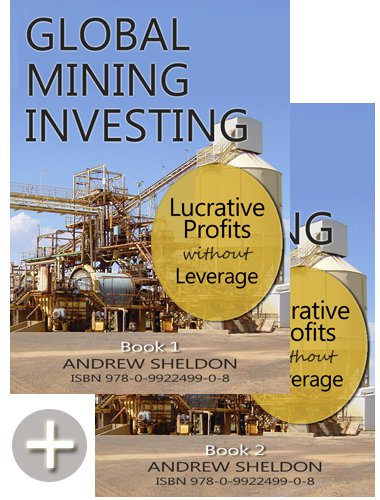I often give alot of lip-service to metals, so I will discuss here what is the best approach to investing in commodities. My experience relates to metals only, so excuse my narrow focus on this commodity group.
There are several ways to invest in commodities:
1.
Futures: This is where we take a leveraged position in a commodity contract at a current forward price for delivery of physical commodity at some future date.
2.
Exchange Traded Options (ETOs): These are rights to buy (call options) or sell (put options) in an underlying financially traded commodity at a certain price, with an OPTION to exercise that contract at a future date. You can hold the contract to maturity, or you can trade it in the secondary options market. Either way, you will be looking to retain a premium over the upfront price you paid for the option + the strike price (paid on maturity), so that you can retain a capital gain. The reference price is of course the underlying security - in this case the commodity price.
3.
Contracts for difference: There are a number of financial intermediaries offering contracts for difference (CFDs). These market makers are effectively creating a market that mirrors the a primary market where 'physically traded' positions are taken. There are a range of vendors, eg. CMC Plc, Saxobank, HSBC, etc. Many of these companies dont just trade commodities, but forex, equities and indices as well, all on generous leverage.
4.
Stocks: There is the opportunity of course to buy stocks in companies that produce metal, or companies with projects that intend to produce metals. Stocks are considered harder because you have to understand the merits of individual stocks, and thats a more laborious proposition. But the implication is that because the 'devil is in the detail', so are the opportunities. Its common to find stocks which are underpriced, particularly at the speculative (small stock) end of the market. Researching on these companies tends to be less well-supported by brokers with the advent of discount, online brokers. The rise of independent research houses however might change that.
5.
Company options: In some markets there are listed, often long-dated options in mining companies that present a very attractive exposure to the underlying security. Maturities might be as little as a few months, or as long as 5 years.
6.
Exchange Traded Funds: There are exchange-listed funds that invest in commodities, blue chip or more speculative emerging producers. Resource funds tend to invest in stocks with no leverage, however its prudent to determine if your commodity investment fund is using leverage to take positions, and also just how actively they trade positions. Are they passive or active managers? Some combination might be best. A pure trading fund will be more risky. A passive fund would be risky if your timing is wrong and leverage is high.
When you consider investing in these options, you should consider the following:
1. What is your risk-reward ratio? How much are you prepared to risk loosing in order to gain X%.
2. What is your market knowledge?
3. How much leverage exposure is prudent? What is the downside given the highly leveraged economy, quite apart from your own finances.
Other facts to consider:
1.
Commodity choices: There are relatively few metals that can actually be traded. Gold, silver, palladium, platinum on the Comex exchange and lead, copper, zinc, aluminium, nickel on the London Metals Exchange (LME). Other metals are not traded in such terminal markets, so you would need to buy stocks to gain exposure to these markets.
2.
Trading platforms: Commodities trading has only become popular in recent years, so the market for trading platforms is not well developed.
3.
Volatility: Commodity prices can be very volatile markets when they are in-play because the size of these markets is very small compared to the equity & bond markets, particularly since derivative contracts in these markets often carry larger positions than the physical markets that underpin them.
Best market to tradeThe best market to trade depends on personal circumstances. If you are accustomed to options or futures trading, you might prefer that, since stocks might exposure you to a range of technical (mining) parameters that you dont understand. Alternatively, you might decide to buy a range of stocks to reduce this risk exposure. Regardless of the market you trade, everything in life carries a risk. If you opt out of life's challenges, you present yourself with a equally daunting financial risk. In conclusion, risk is not avoided, its managed. There is no fixed 'risk exposure'. Risk is a personal factor. You can't say options are risky or not, it depends on your level of preparedness. There is the perception that you are 100% exposed with options, but you retain at least some tangible asset with stocks....but there are always exceptionsd. Big companies are promoted as safer than small companies, but its not always the case. Test those market assumptions that you accept. I've invested in small companies sitting on $5mil in cash but the market places a value of $2-3mil on their listing....which in itself could be worth $3-5mil for a company in a hurry to get listed.























![[Most Recent Quotes from www.kitco.com]](http://www.kitconet.com/charts/metals/gold/t24_au_en_usoz_2.gif)
![[Most Recent Quotes from www.kitco.com]](http://www.kitconet.com/charts/metals/silver/t24_ag_en_usoz_2.gif)
![[Most Recent Quotes from www.kitco.com]](http://www.kitconet.com/charts/metals/platinum/t24_pt_en_uskg_2.gif)
![[Most Recent Quotes from www.kitco.com]](http://www.kitconet.com/charts/metals/palladium/t24_pd_en_usoz_2.gif)